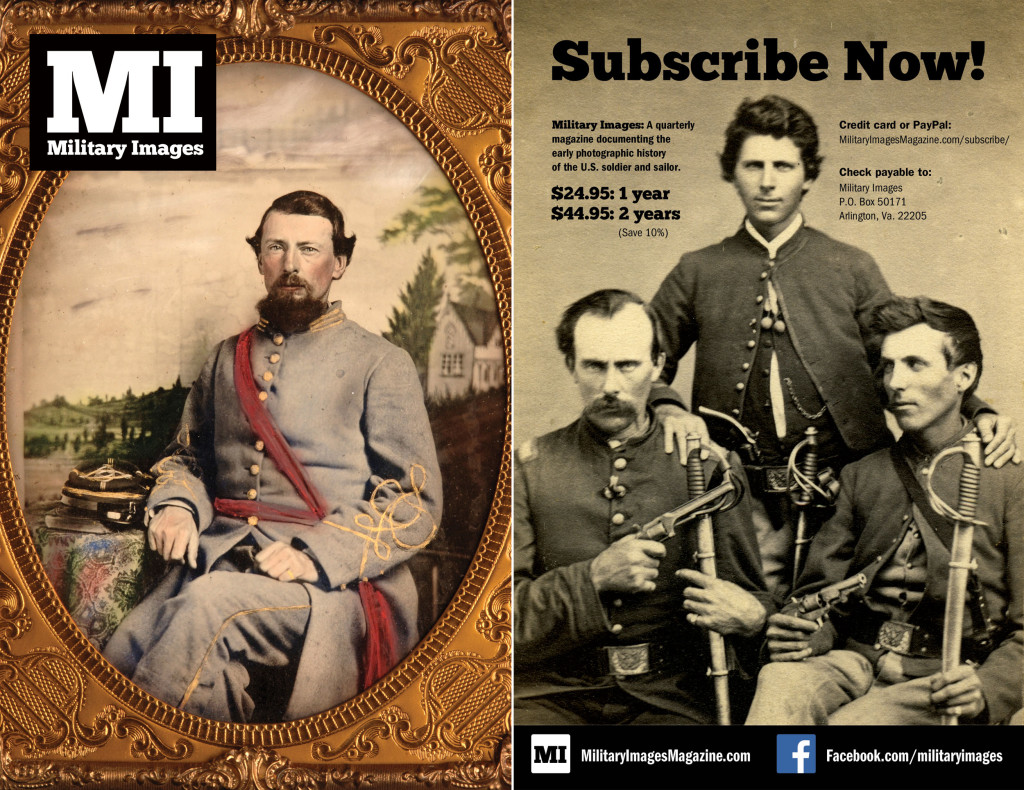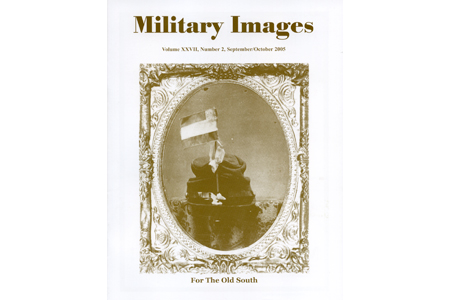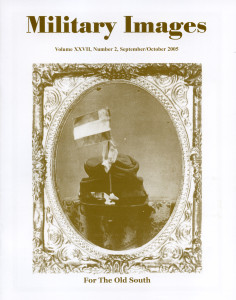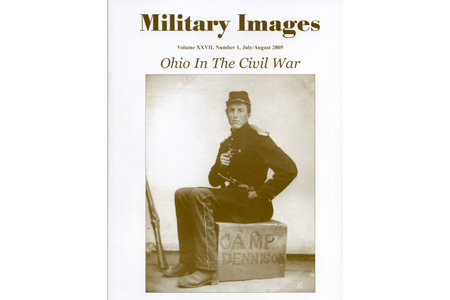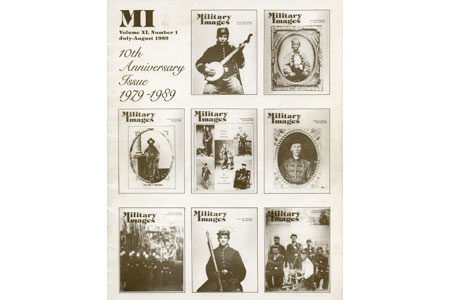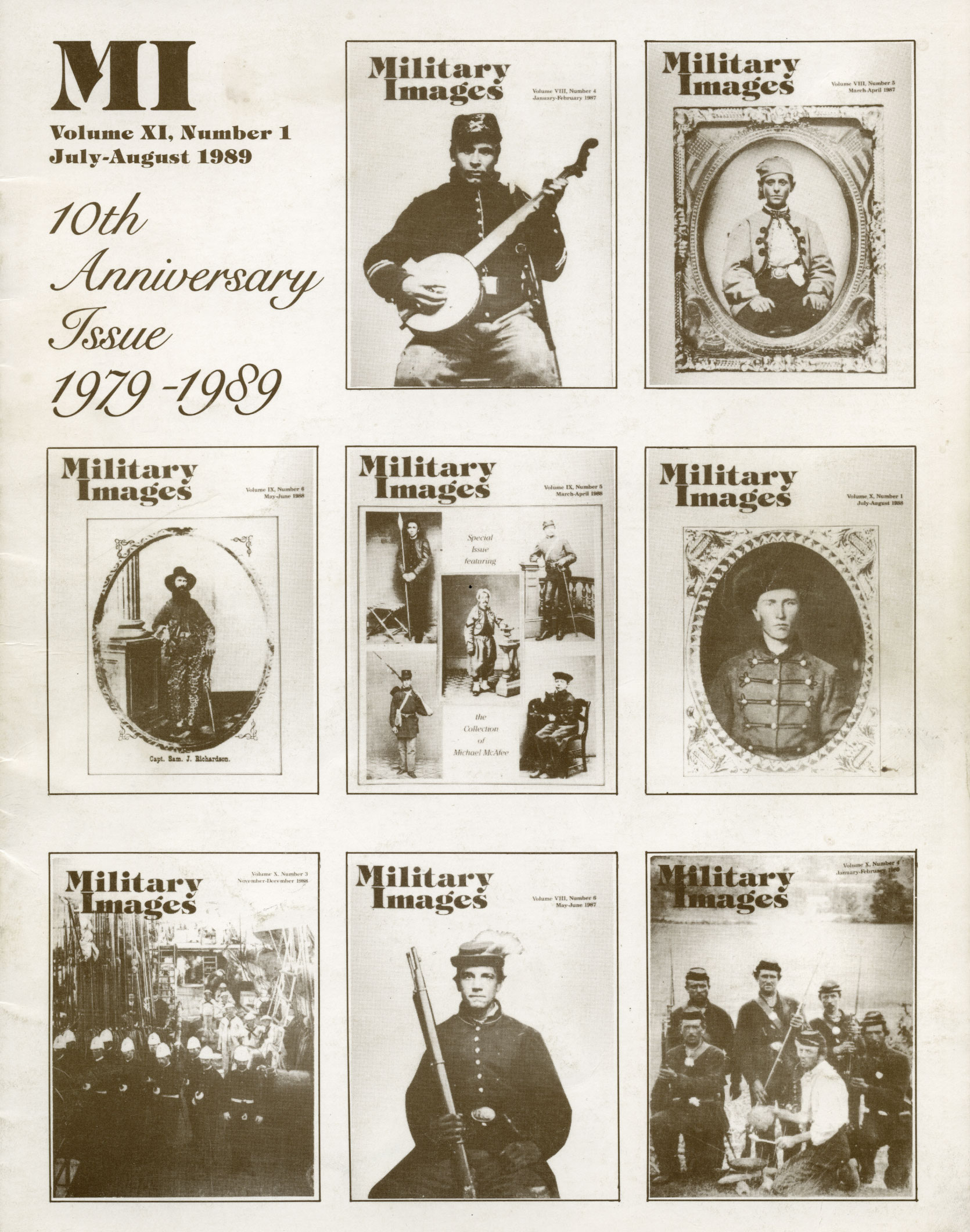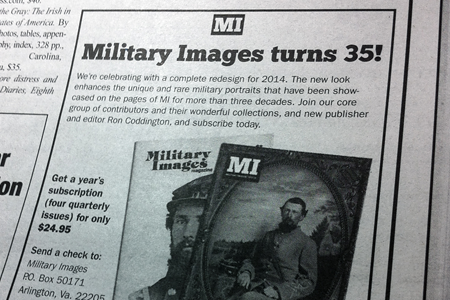The design of a new promotional card that will be distributed at the Low Country Civil War Show and the DC Photo Show early next year went to the printer yesterday. I am very pleased with the design (front and back shown here). Thanks to Anne who pushed me to edit the text. (The first version was much wordier!) And also to David Wynn Vaughan for contributing the wonderful image of the Confederate officer on the front of the card. The federal cavalrymen on the back of the card is part of my collection.
Finding Aid: September/October 2005
The complete issue
Vol. XXVII, No. 2
(40 pages)
Print edition: Visit our store to check availability
Digital edition: Visit JSTOR.org to purchase
Subscribe to MI
Explore the MI Archives: Browse | Advanced search | Tutorial
Inside
Cover image
A unique ninth-plate ambrotype from the David W. Vaughan collection is a Confederate kepi embellished with a small First National pattern flag, ribbon and dogwood flower. The image was likely to have been made in April 1861.
Table of Contents (p. 1)
Editor’s Desk (p. 2)
The editor provides a moving tribute to Brian Pohanka, “A man of boundless energy and courage who dedicated his all-to-shirt life to the preservation of Civil War battlefields and in the discipline of historical scholarship. Indeed, Brian was one of the finest military historians of our time, a man whose body of work included the authorship of many books, countless magazine article and extensive film work. But his influence on the historical community was even greater than the sum of his work, for he was a true inspiration and mentor to countless men and women, whose passion, like his, was history.” The editor also singles out a story in the current issue about an image of the 17th Michigan Infantry. He points out that Military Images does not agree with the author Charles Joyce’s Aug. 3, 1865, dating of the image, but agreed to publish it on the basis of “its historical merits alone.”
Passing in Review (pp. 3-4)
Two books are mentioned: Generals In Bronze: Interviewing the Commanders of the Civil War (Belle Grove Publishing Company) by William B. Styple and Collecting the Confederacy: Artifacts and Antiques from the War Between the States (Savas Beatie) by Shannon Pritchard.
Last Muster for the “Stonewall Regiment;” The Seventeenth Michigan Infantry Returns To The Wolverine State, Summer 1865 by Charles T. Joyce (pp. 5-14)
The author introduces a newly discovered image of the Michiganders in camp as “singularly deceptive. To even the expert eye, it reveals a war-hardened fragment of a Union infantry regiment drawn up in a weedy field by company in ‘column of divisions.’” What follows is a detailed analysis of the regiment and its key personnel that support the theory that the image was produced on Aug. 3, 1865, on the shores of Grass Lake, Mich. Supporting images include a view of the officers of the 17th in camp in 1865 from the State Archives of Michigan and portraits of Col. William H. Withington, Lt. Col. Frederick W. Swift, Maj. Thomas Mathews, Capt. Christian Rath, Capt. Joseph A. Sudborough, Capt. George Goodsell, Lt. and Adjutant Samuel Sizer, Lt. John S. Maltman, Lt. William Leanhouts, QM. Sgt. John M. Lawrence, Corp. Frank Wright and photographer Corydon Randall.
A Tribute to Brian Pohanka (pp. 15-21)
Brian Caldwell Pohanka (1955-2005) is remembered by numerous colleagues and friends associated with him over the course of his eventful life.
The Custer Cyclorama, Revisited by Charles G. Markantes (pp. 22-31)
Subtitled “The subject of a 1983 article in Military Images, the story of the long-lost Custer Cyclorama is explored again,” the author begins by noting that cyclorama paintings were 19th century versions of virtual reality. He continues on to share the history of the Custer Cyclorama, including surviving images of the painting with original 1983 captions by the late Brian Pohanka.
Uniforms & History by Michael J. McAfee (pp. 32-33)
In “The Third Regiment, Michigan Volunteer Infantry, 1864-1865,” McAfee notes that personal accounts by veterans of the Civil War can be extremely valuable to the student of history, but Four Years Campaigning in the Army of the Potomac by color sergeant D.G. Crotty of the 3rd is unfortunately not a useful reference. McAfee details why the volume raises more questions than it answers, and illustrates his text with a tintype of the color guard of the 3rd and a carte de visite of Anna Etheridge, a nurse who found a home with the boys of the regiment.
The Confederate Soldier (p. 34)
A sixth-plate tintype from the David W. Vaughan collection pictures Pvt. Charles Holtzclaw, who served in Company H of the 6th Virginia Cavalry.
Henley Fugate 63rd Tennessee Infantry C.S.A. by John Sickles (p. 35)
Fugate suffered the loss of an arm at Chickamauga after he was struck by a Union cannon shot. A carte de visite of Fugate and his second wife, likely taken in the 1870s or 1880s, accompanies the narrative.
A Palmetto Artillerist and the Columbia Flying Artillery by John Mills Bigham (pp. 36-37)
John W. Self served as second lieutenant of Waties’ Battery B, Palmetto Battalion of Light Artillery, which was first known as the Columbia Artillery and Columbia Flying Artillery. Details of his military service and a brief history of this artillery organization are included.
Stragglers (p. 38)
Three images include a Union soldier with a Sharps rifle, a young Yank with a Bowie knife and a Colt pocket revolver and an unidentified Confederate soldier wearing color shoulder straps.
Sutler’s Row (p. 39)
The Last Shot (p. 40)
A carte de visite from the Chris Nelson collection pictures two Kentucky National Guardsmen portraying Confederates.
Finding Aid: July/Aug. 2005
The complete issue
Vol. XXVII, No. 1
(48 pages)
Print edition: Visit our store to check availability
Digital edition: Visit JSTOR.org to purchase
Subscribe to MI
Explore the MI Archives: Browse | Advanced search | Tutorial
Inside
Cover image
A sixth-plate ferrotype from the Brad L. Pruden collection is a portrait of a member of the Tyler Guard, which became Company G of the 7th Ohio Infantry. The soldier sits on a packing crate labeled “Camp Dennison.”
Table of Contents (p. 1)
Editor’s Desk and Mail Call (p. 2)
The editor introduces “a unique view of the great State of Ohio in the Civil War” through representative examples of the 300,000 volunteers who served from the Buckeye State.
Through The Camera’s Eye: Part One, Ohio Soldiers 1861 by Larry M. Strayer and Brad L. Pruden (pp. 5-13)
The authors document the varied uniforms worn by Ohioans in 1861. A total of 22 period images are showcased. Identified soldiers include William S. Wickham of the 8th Infantry, Frank Bell of the 18th Infantry, the field officers of the 1st and 2nd infantries in late April 1861, a squad of five soldiers who served in Company K of the 11th Infantry, George L. Waterman of the 1st Infantry, Oscar Ladley of the 16th Infantry, Joseph Wright of the 20th Infantry, Company E of the 5th Infantry in June 1861, Joel C. Tracy of the 3rd Ohio Infantry, Asbury Oldroyd of the 16th Infantry, officers of the 14th Infantry about the summer of 1862, Lancelot L. Scott of the 18th Infantry, Homer Yates of the 1st Light Artillery and a drummer believed to be William V. Haines of the 49th Infantry.
Through The Camera’s Eye: Part Two, Ohio Soldiers 1862-1864 by Larry M. Strayer and Brad L. Pruden (pp. 14-22)
The authors document the evolution to standardized uniforms and equipment in the second wave of enlistments through the “veteran’s craze” of 1864. A total of 19 period images are showcased. Identified soldiers include Lycurgus Bishop of the 1st Light Artillery, four men from Company C of the 9th Infantry, members of the Pearl Street Rifles of the Cincinnati Home Guard about 1862, sergeants of Company A of the 34th Infantry (Piatt’s Zouaves), Company I of the 42nd Infantry at Plaquemine, La., in January 1864, field and staff officers of the 47th Infantry, Col. Augustus Parry and Capt. George M. Ziegler of the 47th Infantry, John K. Duke of the 53rd Infantry, Aaron J. Glathart of the 57th Infantry, James A. Bridges of the 70th Infantry, John Warner of the 76th Infantry, Charles D. Miller of the 76th Infantry, Charles D. Rathbone with the flag of the 24th Infantry, James Gallagher of the 78th Infantry, the funeral bier of Capt. Martin Armstrong of the 81st Infantry, Benjamin P. Brandt of the 120th Infantry and William F Barr of the 121st Infantry and 4th Battalion of the Pioneer Brigade.
Through The Camera’s Eye: Part Three, Ohio Veterans 1865 by Larry M. Strayer and Brad L. Pruden (pp. 23-27)
The authors document the last months of the war and the rush by soldiers to remember their service with badges and photographs. A total of 12 period images are showcased. Identified soldiers include William S. Friesner of the 58th Infantry, Joseph McElroy of the Veteran Volunteer Corps, Robert N. Traver of the 2nd Veteran Volunteer Corps, Richard Lemon of the 3rd Veteran Volunteer Corps, David R. Sims of the U.S. Navy with his wife Adelaide and daughter Lissa, Gen. Stephen J. McGroarty of the 82nd Infantry and his staff, Col. John W. Fuller of the 27th Infantry, Gen. John W. Sprague of the 17th Corps and his staff, James A. Kittle and Alonzo Corser with the regimental colors of the 55th Infantry, The daughter of Col. Jack Casement of the 103rd Infantry standing with the national flag of her father’s regiment and Capt. Warren W. Cooke with lieutenants George M. Young and William H. Wood of the 14th Infantry.
“Family Honor:” Mortimer and Wells Leggett in the Civil War photos from the collections of Larry Strayer and David Neville (p. 28)
A portrait of Maj. Gen. Mortimer D. Leggett pictured as colonel of the 78th Ohio Infantry and two images of Wells W. Leggett, a wartime view as chief engineer of the 17th Corps and a postwar portrait as a West Point cadet.
Six Buckeyes From The Collection of Stephen Altic (pp. 29-31)
Portraits include Pvt. Benjamin Franklin Coffman, Corp. Thomas J. Coen and an unidentified member of the 1st Infantry, an unidentified member of the 54th Infantry and privates William H. Hay and Allen Worthington of the 71st Infantry.
George Crook by Mark Kasal (pp. 32-33)
Four portraits picture the noted Union cavalry general.
Charles Jesson: Requiem for a Cannoneer by Mike Fitzpatrick (p. 34)
English-born Jesson began his war service with the 25th Ohio Infantry in 1861 and died of disease in May 1863—just two months after he received his corporal’s stripes.
William S. Bowman: Game Lad with a Gimp Leg by Mike Fitzpatrick (p. 35)
The Ohioan was only 16 when he enlisted in his home state’s 77th Infantry in the fall of 1861. After a bout of typhoid fever left him lame, he spent the rest of the war as a clerk, nurse and other less physically strenuous duties.
Ohioans From the Collection of Ken Turner (pp. 36-37)
Portraits include Pvt. William Lewis of the 5th Cavalry, Lt. John A. Mendenhall of the 75th Infantry (captured at Gettysburg on July 2, 1863), Frank Rockefeller of the 7th Infantry (brother of John D. Rockefeller), Sgt. George H. Jordan of the 1st Light Artillery and Lt. Col. James S. Crall of the 82nd Infantry with his counterpart in the 101st Illinois Infantry, John B. LeSage.
Ohio Cartes de Visite From the Collection of Steven A. Morr (pp. 38-39)
Portraits include Capt. William J. Colliflower of the 63rd Infantry, Capt. Jacob G. Bittinger, Capt. William H. Farber, Capt. Alonzo W. Hancock and Pvt. Isaac M. Thomas of the 64th Infantry, Pvt. Perry J. Maine of the 15th Infantry, 1st Lt. William A. Bell of the 4th and 65th infantries, Asst. Surg. John McCurdy of the 23rd Infantry and Asst. Surg. Nathan S. Richardson of the 118th Infantry.
Michael Hammerson’s Buckeyes (pp. 40-42)
Portraits include a hospital steward identified as Henry Hisler of the 103rd Infantry, a bewhiskered sergeant photographed in Cincinnati, Pvt. Edson M. Schryver of the 114th Infantry and 1st Louisiana Cavalry, Pvt. John P. Hall of the 7th Ohio Cavalry and four soldiers from the 37th Infantry: Capt. Paul Wittich, 1st Lt. Theodore Nieberg, 1st Lt. Jacob Ritter and 2nd Lt. William Weiss.
Ohioans From the Collections of Our Readers (pp. 43-46)
Portraits include Sgt. John Franklin Shearer of the 94th Infantry, a young infantryman standing at “Order Arms,” a fully equipped soldier photographed in Cincinnati, troopers from the 1st Cavalry, twin brothers Edward L. (52nd Infantry) and Fredrick P. Anderson (181st Infantry), a soldier dressed in a mounted enlisted man’s overcoat and Maj. John B. Rice of the 72nd Infantry with Capt. Richard B. Wood of the 3rd Cavalry, a soldier with what nay be a 23rd Corps badge, a soldier who served in the 4th or 8th infantries, Capt. David H. Moore of the 87th Infantry and Maj. George L. Wood of the 125th Infantry.
Sutler’s Row (p. 47)
The Last Shot (p. 48)
A circa 1888 cabinet card from the Chris Nelson collection pictures veterans of Grand Army of the Republic Post No. 23 gathered around the cannon “Millennium” which is composed of buckeyes.
Finding Aid: July/Aug. 1989
The complete issue
Vol. XI, No. 1
(32 pages)
Print edition: Visit our store to check availability
Digital edition: Visit JSTOR.org to purchase
Subscribe to MI
Explore the MI Archives: Browse | Advanced search | Tutorial
Inside
Cover image
A selection of covers from the past five years is featured.
Editor’s Desk (p. 1)
The editor observes the 10th anniversary of the magazine by thanking subscribers and contributors for their generosity, and offering an extended Stragglers section to display some of the best images from private collectors.
Mail Call (p. 2)
The letters to the editor include congratulations on the 10th anniversary with the comment, “MI is the only magazine of its kind and it certainly fills a need in in the military collecting field.” Also, more comments about Dave Mark’s Marylander issue.
Passing in Review (p. 3)
Six publications are mentioned: The Illustrated Confederate Reader (Harper & Row) by Rod Gregg, Soldiers Blue and Gray (University of South Carolina Press) by James I. Robertson, Two Great Rebel Armies (University of North Carolina Press) by Richard M. McMurray, Photographer on an Army Mule (University of Oklahoma Press) by Maurice Frank with Casey Barthelmess, and two new periodicals of note: Company Front, the newsletter of the 26th Regiment North Carolina Troops, and The Civil War News (revamped from the Civil War Book Exchange).
What Happened To This Man’s Navy? A brief history of Yeomanettes by John A. Stacy (pp. 4-7)
A 1917 authorization to enlist women as Yeoman led to a massive influx of young ladies to perform the traditional duties of this rank, and free up men to fight on the front lines. Portraits of identified yeomen include Lucy and Sydney Burleson, Mary B. Davidson, Edith R. Barrow and Mrs. E. DuBerry Sutherland.
Uncommon Soldiers (pp. 8-15)
In the introduction to this collection of images and personal accounts, the author declares, “Vignette portraits of individuals whose contributions made nineteenth century military life more colorful, to say the least. Some were scoundrels, some were heroes, all were Americans. Featured stories include Col. Myron Beaumont of the 1st New Jersey Cavalry, Sarah Malinda “Sam” Blaylock of the 26th North Carolina Troops, Maj. Levi Twiggs of the U.S. Marine Corps, Pvt. Amos Dalton of the Hampton Legion Infantry, Capt. Ezra Havens of the Mississippi Marine Brigade and Sgt. Harlan Cobb of the U.S. Engineers.
Americans All? A photo mystery game from Anthony Gero (pp. 16-17)
A group of 10 military portraits that date from 1870-1900 are featured. The goal: Guess which are American soldiers and which are not.
Military Imagery, An album of photographs from the collections of our readers (pp. 18-27)
A who’s who of collectors includes Donald Bates, Randy Beck, Michael Bremer, Jerry Coody, George Cress, Norman Delaney, John Ertzgaard, Al Fleming, Scotty Fritts, Ed Frutchey, Anthony Gero, William Gladstone, Brooks Hamm, Randall Hawk, Howard Hoffman, Lee Joyner, Robert Kotchian, Steven Lister, Terry O’Leary, Roy Mantle, L.B. Paul, Paul Reeder, Stephen Rogers, Bill Roll, Martin Schoenfeld, William Schultz, John Sickles, William Styple, David Sullivan, Steve Sullivan, John Wernick, Kean Wilcox and Donald Wisnoski. A total of 45 images are featured. Some are identified: Allen P. Hamm of the C.S. Marines, Capt. Jeremiah Rees of the Pennsylvania Militia, Michajah Berry of Mississippi, Confederate navy Lt. John MacIntosh Kell of the Sumter and Alabama, Boatswain’s Mate James Gurney of the U.S. flagship Severn, Lt. Edmund Reed of the Confederate vessel Stonewall, Randolph Axson of the 2nd Company, Washington Artillery of New Orleans, Union Gen. Alexander Asboth and Sgt. George Williams of the 146th New York Infantry.
Uniforms & History by Michael J. McAfee (pp. 28-29)
In “Fourth Battalion of Rifles, Massachusetts Militia 1860-1861,” McAfee explores the history of this Boston militia group that became the nucleus of the 13th Massachusetts Infantry during the Civil War. Two portraits illustrate the text, Sgt. Sigourney Wales and 2nd Lt. Augustus N. Sampson.
Posing for the Carte de Visite Photograph by Henry Deeks (p. 30)
Described as “an article about style,” the author asserts that carte de visite subjects appeared more casual than the more formal poses seen in earlier images. As a result, the individuality of the subjects is more pronounced. Five images illustrate the text, A.A.E. Disderi, who invented the carte de visite, French politician Comte Frederic Alfred Pierre de Falloux, Capt. Benjamin W. Crowninshield of the 1st Massachusetts Cavalry, 2nd Lt. Francis Washburn of the 1st Massachusetts Cavalry and 1st Lt. Henry May Bond of the 20th Massachusetts Infantry.
Sutlers’ Row (pp. 31-32)
Back cover
More MI covers.
The First Issue of Military Images Magazine
 Those who you who have followed my posts about the MI archives know that the back issues I inherited have major gaps—entire years are completely missing. Frankly, I was surprised and disappointed at the situation. After my initial reaction settled, my history gene kicked in, and I set a goal to build a full set that includes every published issue.
Those who you who have followed my posts about the MI archives know that the back issues I inherited have major gaps—entire years are completely missing. Frankly, I was surprised and disappointed at the situation. After my initial reaction settled, my history gene kicked in, and I set a goal to build a full set that includes every published issue.
Yesterday, I came much closer to achieving the goal. Thanks to a longtime subscriber who was willing to part with some of his collection, I added 40 original issues, including the coveted Volume I, Issue 1, shown here. Delighted to have them all, and am now will begin the process of scanning the covers and placing them in archival bags.
Military Images Turns 35!
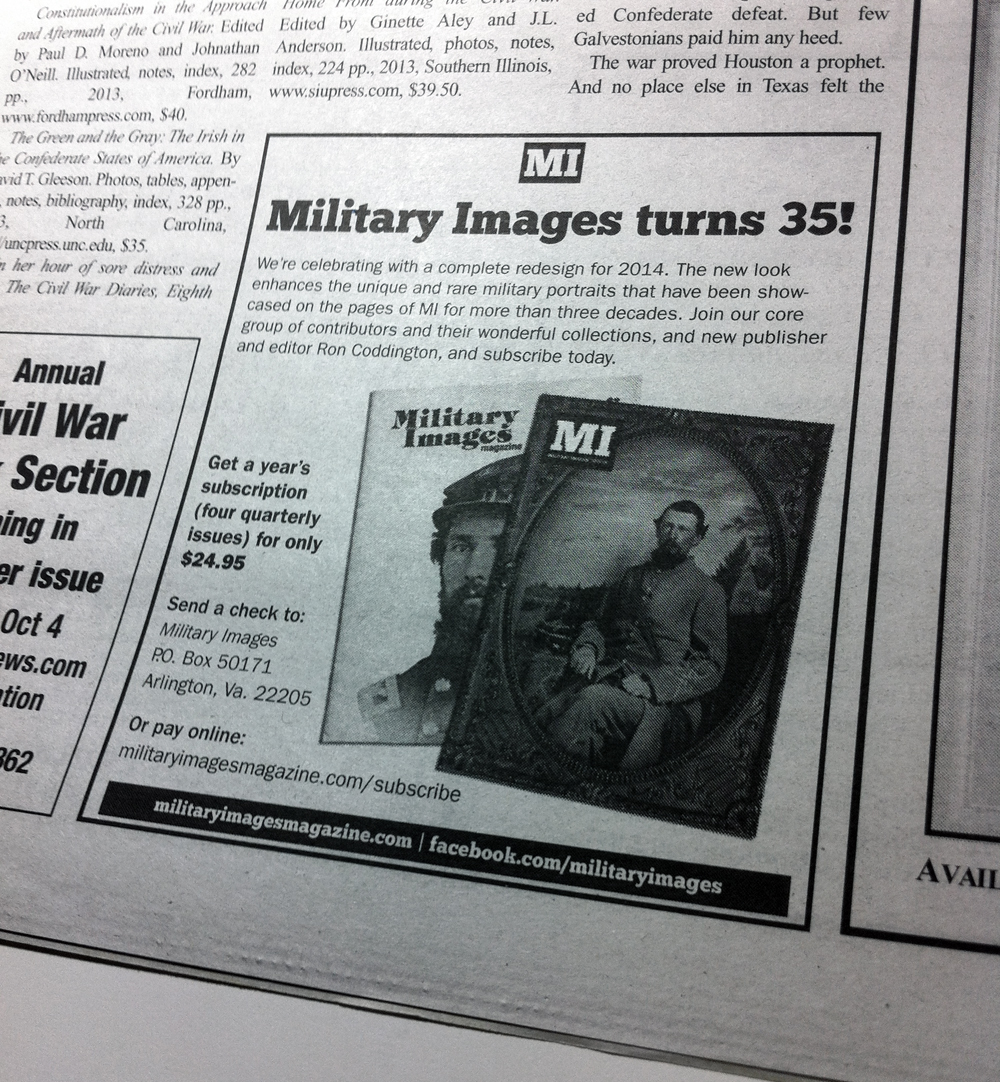 This is the title of a new ad just published in the Civil War News, and it features an early MI cover and the proposed cover for the next issue. The text reads: “We’re celebrating with a complete redesign for 2014. The new look enhances the unique and rare military portraits that have been showcased on the pages of MI for more than three decades. Join our core group f contributors and their wonderful collections, and new publisher and editor Ron Coddington and subscribe today. Get a year’s subscription (four quarterly issues) for only $24.95”
This is the title of a new ad just published in the Civil War News, and it features an early MI cover and the proposed cover for the next issue. The text reads: “We’re celebrating with a complete redesign for 2014. The new look enhances the unique and rare military portraits that have been showcased on the pages of MI for more than three decades. Join our core group f contributors and their wonderful collections, and new publisher and editor Ron Coddington and subscribe today. Get a year’s subscription (four quarterly issues) for only $24.95”


